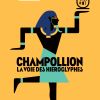Champollion. La voie des hiéroglyphes
À l’occasion du 200e anniversaire du déchiffrement des hiéroglyphes, et pour célébrer son 10e anniversaire, le Louvre-Lens organise une grande exposition dédiée à l’un des symboles les plus fascinants de la civilisation égyptienne : les hiéroglyphes.
C’est à Jean-François Champollion (1790-1832) que l’on doit le déchiffrement de ce système d’écriture apparu vers 3200 avant J.-C. En se fondant sur les travaux de ses prédécesseurs, et grâce à son étude de la célèbre Pierre de Rosette, découverte en 1799, Champollion est parvenu à lever le voile sur ce qui fut l’un des plus grands mystères de la civilisation pharaonique.
L’exposition propose ainsi de décrypter l’histoire de Jean-François Champollion et le contexte – intellectuel, scientifique, culturel, archéologique mais aussi politique – qui a permis à ce savant de percer le secret millénaire des hiéroglyphes.
Grâce à un parcours de plus de 350 œuvres, entre sculptures, peintures, objets d’arts, documents et arts graphiques, cette rétrospective ambitieuse est l’occasion pour le Louvre-Lens de rendre hommage à celui qui fut le premier conservateur du musée égyptien du Louvre au début du 19e siècle, Jean-François Champollion.
__
Champollion, On the trail of hieroglyphics
To mark the 200th anniversary of the decipherment of hieroglyphs, and to celebrate its 10th anniversary, the Louvre-Lens is organising a large exhibition devoted to one of the most fascinating symbols of Egyptian civilization: hieroglyphs.
This writing system, which appeared in around 3300 BC, was deciphered by Jean-François Champollion (1790–1832). Drawing on the work of his predecessors, and thanks to his study of the famous Rosetta Stone, discovered in 1799, Champollion managed to solve one of the biggest mysteries of the civilization of the pharaohs. The letter he wrote to Bon-Joseph Dacier (1742–1833), the Hellenist and member of the Académie des Inscriptions et Belles-Lettres, in September 1822 became the key text of the decipherment of hieroglyphs. In it Champollion explains how hieroglyphic writing works, drawing on his knowledge of other forms of writing used by the ancient Egyptians, such as demotic, Greek and hieratic.
A veritable sacred form of writing, described by the Egyptians themselves as the “divine word”, hieroglyphic writing was used on every surface, from papyrus to stone and metal, in religious, administrative and funerary contexts.
In the exhibition, large-format works will rub shoulders with smaller objects, highlighting the richness of both this writing system and one of humankind’s oldest civilizations. The exhibition sets out to decipher the story of Jean-François Champollion and the context – intellectual, scientific, cultural, archaeological and political – that enabled this scholar to solve the age-old secret of hieroglyphs.
Thanks to an immersive exhibition design featuring more than 350 works, embracing sculptures, paintings, objets d’art, documents and the graphic arts, this ambitious retrospective is an opportunity for the Louvre-Lens to pay tribute to the man who was the first curator of the Louvre’s Egyptian museum in the early 19th century, Jean-François Champollion.

